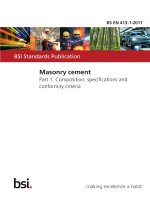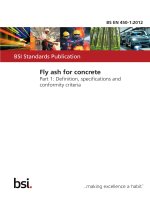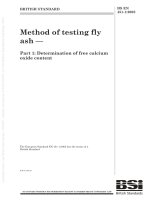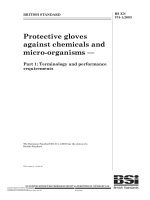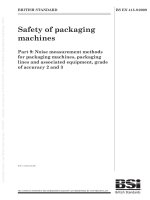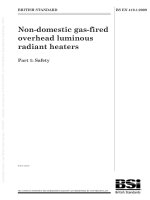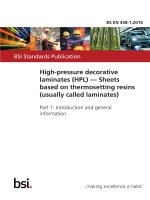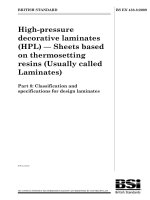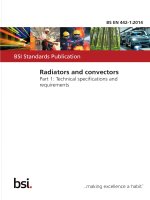Bsi bs en 62134 1 2009
Bạn đang xem bản rút gọn của tài liệu. Xem và tải ngay bản đầy đủ của tài liệu tại đây (1.17 MB, 26 trang )
Licensed Copy: athen reading, Reading University Library, 24/01/2010 04:48, Uncontrolled Copy, (c) BSI
BS EN 62134-1:2009
BSI Standards Publication
Fibre optic interconnecting devices
and passive components — Fibre
optic closures —
Part 1: Generic specification
NO COPYING WITHOUT BSI PERMISSION EXCEPT AS PERMITTED BY COPYRIGHT LAW
raising standards worldwide™
BRITISH STANDARD
Licensed Copy: athen reading, Reading University Library, 24/01/2010 04:48, Uncontrolled Copy, (c) BSI
BS EN 62134-1:2009
National foreword
This British Standard is the UK implementation of EN 62134-1:2009. It is
identical to IEC 62134-1:2009. It supersedes BS EN 62134-1:2002 which is
withdrawn.
The UK participation in its preparation was entrusted by Technical Committee
GEL/86, Fibre optics, to Subcommittee GEL/86/2, Fibre optic interconnecting
devices and passive components.
A list of organizations represented on this committee can be obtained on
request to its secretary.
This publication does not purport to include all the necessary provisions of a
contract. Users are responsible for its correct application.
© BSI 2010
ISBN 978 0 580 58772 6
ICS 33.180.99
Compliance with a British Standard cannot confer immunity from
legal obligations.
This British Standard was published under the authority of the Standards
Policy and Strategy Committee on 31 January 2010
Amendments issued since publication
Amd. No.
Date
标准分享网 www.bzfxw.com 免费下载
Text affected
Licensed Copy: athen reading, Reading University Library, 24/01/2010 04:48, Uncontrolled Copy, (c) BSI
BS EN 62134-1:2009
EUROPEAN STANDARD
EN 62134-1
NORME EUROPÉENNE
November 2009
EUROPÄISCHE NORM
ICS 33.180.99
Supersedes EN 62134-1:2002
English version
Fibre optic interconnecting devices and passive components Fibre optic closures Part 1: Generic specification
(IEC 62134-1:2009)
Dispositifs d'interconnexion
et composants passifs à fibres optiques Boitiers à fibres optiques Partie 1: Spécification générique
(CEI 62134-1:2009)
Lichtwellenleiter Verbindungselemente
und passive Bauteile Lichtwellenleitergarnituren Teil 1: Fachgrundspezifikation
(IEC 62134-1:2009)
www.bzfxw.com
This European Standard was approved by CENELEC on 2009-10-01. CENELEC members are bound to comply
with the CEN/CENELEC Internal Regulations which stipulate the conditions for giving this European Standard
the status of a national standard without any alteration.
Up-to-date lists and bibliographical references concerning such national standards may be obtained on
application to the Central Secretariat or to any CENELEC member.
This European Standard exists in three official versions (English, French, German). A version in any other
language made by translation under the responsibility of a CENELEC member into its own language and notified
to the Central Secretariat has the same status as the official versions.
CENELEC members are the national electrotechnical committees of Austria, Belgium, Bulgaria, Cyprus, the
Czech Republic, Denmark, Estonia, Finland, France, Germany, Greece, Hungary, Iceland, Ireland, Italy, Latvia,
Lithuania, Luxembourg, Malta, the Netherlands, Norway, Poland, Portugal, Romania, Slovakia, Slovenia, Spain,
Sweden, Switzerland and the United Kingdom.
CENELEC
European Committee for Electrotechnical Standardization
Comité Européen de Normalisation Electrotechnique
Europäisches Komitee für Elektrotechnische Normung
Central Secretariat: Avenue Marnix 17, B - 1000 Brussels
© 2009 CENELEC -
All rights of exploitation in any form and by any means reserved worldwide for CENELEC members.
Ref. No. EN 62134-1:2009 E
Licensed Copy: athen reading, Reading University Library, 24/01/2010 04:48, Uncontrolled Copy, (c) BSI
BS EN 62134-1:2009
EN 62134-1:2009
-2-
Foreword
The text of document 86B/2846/FDIS, future edition 2 of IEC 62134-1, prepared by SC 86B, Fibre optic
interconnecting devices and passive components, of IEC TC 86, Fibre optics, was submitted to the
IEC-CENELEC parallel vote and was approved by CENELEC as EN 62134-1 on 2009-10-01.
This European Standard supersedes EN 62134-1:2002.
The main changes with respect to EN 62134-1:2002 are listed below:
– addition and rewording of some terms and definitions;
– reconsideration of type, style and variant in the requirements;
– removal of quality assessment procedures.
The following dates were fixed:
– latest date by which the EN has to be implemented
at national level by publication of an identical
national standard or by endorsement
(dop)
2010-07-01
– latest date by which the national standards conflicting
with the EN have to be withdrawn
(dow)
2010-10-01
Annex ZA has been added by CENELEC.
__________
www.bzfxw.com
Endorsement notice
The text of the International Standard IEC 62134-1:2009 was approved by CENELEC as a European
Standard without any modification.
In the official version, for Bibliography, the following notes have to be added for the standards indicated:
IEC 61073-1
NOTE Harmonized as EN 61073-1:2009 (not modified).
IEC 61756-1
NOTE Harmonized as EN 61756-1:2006 (not modified).
IEC 61758-1
NOTE Harmonized as EN 61758-1:2008 (not modified).
__________
标准分享网 www.bzfxw.com 免费下载
Licensed Copy: athen reading, Reading University Library, 24/01/2010 04:48, Uncontrolled Copy, (c) BSI
BS EN 62134-1:2009
-3-
EN 62134-1:2009
Annex ZA
(normative)
Normative references to international publications
with their corresponding European publications
The following referenced documents are indispensable for the application of this document. For dated
references, only the edition cited applies. For undated references, the latest edition of the referenced
document (including any amendments) applies.
NOTE When an international publication has been modified by common modifications, indicated by (mod), the relevant EN/HD
applies.
Publication
Year
IEC 60027
Series Letter symbols to be used in electrical
technology
IEC 60050-731
-
IEC 60068
Series Environmental testing
1)
1)
IEC 60068-2-10
-
IEC 60617
Database
IEC 60695
Title
EN/HD
Year
EN 60027
Series
-
-
EN 60068
Series
Environmental testing Part 2-10: Tests - Test J and guidance:
Mould growth
EN 60068-2-10
2005
Graphical symbols for diagrams
-
-
International Electrotechnical Vocabulary
(IEV) Chapter 731: Optical fibre communication
www.bzfxw.com
Series Fire hazard testing
EN 60695
2)
Series
-
1)
Fire hazard testing EN 60695-1-1
Part 1-1: Guidance for assessing the fire
hazard of electrotechnical products - General
guidelines
2000
2)
IEC 60793-2
-
1)
Optical fibres Part 2: Product specifications - General
EN 60793-2
2008
2)
IEC 60794-2
-
1)
Optical fibre cables EN 60794-2
Part 2: Indoor cables - Sectional specification
2003
2)
IEC 60825-1
-
1)
Safety of laser products Part 1: Equipment classification and
requirements
EN 60825-1
2007
2)
IEC 61300-2
Series Fibre optic interconnecting devices and
passive components - Basic test and
measurement procedures Part 2: Tests
EN 61300-2
Series
IEC 61300-3
Series Fibre optic interconnecting devices and
passive components - Basic test and
measurement procedures Part 3: Examinations and measurements
EN 61300-3
Series
IEC 61753-1
-
IEC 61754
Series Fibre optic connector interfaces
IEC 60695-1-1
IEC/TR 61930
-
1)
1)
1)
Undated reference.
2)
Valid edition at date of issue.
EN 61753-1
Fibre optic interconnecting devices and
passive components performance standard Part 1: General and guidance for performance
standards
Fibre optic graphical symbology
2007
2)
EN 61754
Series
-
-
Licensed Copy: athen reading, Reading University Library, 24/01/2010 04:48, Uncontrolled Copy, (c) BSI
BS EN 62134-1:2009
EN 62134-1:2009
-4Year
Publication
1)
Title
EN/HD
Year
Fibre optic - Terminology
-
-
EN 62005
Series
IEC/TR 61931
-
IEC 62005
Series Reliability of fibre optic interconnecting
devices and passive components
IEC QC 001002-3
2005
ISO 129-1
-
ISO 286-1
IEC Quality Assessment System
for Electronic Components (IECQ) - Rules of
Procedure Part 3: Approval procedures
-
1)
Technical drawings - Indication of dimensions and tolerances Part 1: General principles
-
-
1)
ISO system of limits and fits EN 20286-1
Part 1: Bases of tolerances, deviations and fits
1993
2)
ISO 1101
-
1)
Geometrical Product Specifications (GPS) - EN ISO 1101
Geometrical tolerancing - Tolerances of form,
orientation, location and run-out
2005
2)
ISO 4892-3
-
1)
Plastics - Methods of exposure to laboratory
light sources Part 3: Fluorescent UV lamps
EN ISO 4892-3
2006
2)
ISO 8601
-
1)
Data elements and interchange formats Information interchange - Representation of
dates and times
-
-
www.bzfxw.com
标准分享网 www.bzfxw.com 免费下载
Licensed Copy: athen reading, Reading University Library, 24/01/2010 04:48, Uncontrolled Copy, (c) BSI
BS EN 62134-1:2009
–2–
62134-1 © IEC:2009
CONTENTS
INTRODUCTION.....................................................................................................................6
1
Scope ...............................................................................................................................7
2
Normative references .......................................................................................................7
3
Terms and definitions .......................................................................................................8
4
Requirements ................................................................................................................. 10
4.1
Classification......................................................................................................... 10
4.1.1 General ..................................................................................................... 10
4.1.2 Type .......................................................................................................... 10
4.1.3 Style .......................................................................................................... 11
4.1.4 Variant ...................................................................................................... 11
4.1.5 Arrangement.............................................................................................. 12
4.1.6 Normative reference extensions ................................................................ 12
4.1.7 Environmental category – Service categories ............................................ 13
4.2 Documentation ...................................................................................................... 13
4.2.1 Specification system .................................................................................. 13
4.2.2 Symbols .................................................................................................... 15
4.2.3 Drawings ................................................................................................... 15
4.2.4 Measurements ........................................................................................... 15
4.2.5 Tests ......................................................................................................... 15
4.2.6 Test reports ............................................................................................... 16
4.2.7 Instructions for use .................................................................................... 16
4.3 Standardisation system ......................................................................................... 16
4.3.1 Specification standards ............................................................................. 16
4.3.2 Interface standards.................................................................................... 16
4.3.3 Performance standards.............................................................................. 16
4.3.4 Reliability standards .................................................................................. 17
4.4 Design and construction ........................................................................................ 18
4.4.1 Materials ................................................................................................... 18
4.5 Workmanship ........................................................................................................ 18
4.6 Quality .................................................................................................................. 18
4.7 Performance.......................................................................................................... 19
4.8 Identification and marking ..................................................................................... 19
4.8.1 General ..................................................................................................... 19
4.8.2 Variant identification number ..................................................................... 19
4.8.3 Component marking .................................................................................. 19
4.8.4 Package marking ....................................................................................... 19
4.9 Storage conditions ................................................................................................ 19
4.10 Safety ................................................................................................................... 19
Bibliography.......................................................................................................................... 21
www.bzfxw.com
Figure 1 – Standardisation system ........................................................................................ 18
Licensed Copy: athen reading, Reading University Library, 24/01/2010 04:48, Uncontrolled Copy, (c) BSI
BS EN 62134-1:2009
62134-1 © IEC:2009
–3–
Table 1 – Operating service environments ............................................................................ 13
Table 2 – Multilevel IEC specification structure ..................................................................... 14
www.bzfxw.com
标准分享网 www.bzfxw.com 免费下载
Licensed Copy: athen reading, Reading University Library, 24/01/2010 04:48, Uncontrolled Copy, (c) BSI
BS EN 62134-1:2009
–6–
62134-1 © IEC:2009
INTRODUCTION
Closures comprise a broad component family that functions to protect, secure and store
passive fibre optic components (such as splices or connectors) or other non-interconnecting
devices (such as optical branching devices). They are installed at either indoor or outdoor
locations, and provide access to the optical path of one or more cabled optical fibres. They
also generally provide a fibre management system for the orderly management, routing, and
storage of optical fibres. Configuration definitions may specify integrated functions, or permit
grouped combinations of compatible independent sub-units. Specific classification
requirements vary, and may or may not include isolation from environmental hazards (such as
water ingress), structure codes (such as fire safety), or other appropriate considerations.
Closures are not intended to provide the primary packaging or structure for uncabled optical
fibre splices (such as a rigid mechanical splice shell, or a fusion splice protection sleeve).
Specification for those devices is defined in IEC 61073-1.
It is also intended that closures specified under this standard are not sufficiently characterized
for continuous brine or deep-water submersion. Examples of this are oceanic or lake-crossing
applications. Cables, closures and installation methods suited to this use are highly
specialised and are not within the scope of this standard or supporting test procedures.
www.bzfxw.com
Licensed Copy: athen reading, Reading University Library, 24/01/2010 04:48, Uncontrolled Copy, (c) BSI
BS EN 62134-1:2009
62134-1 © IEC:2009
–7–
FIBRE OPTIC INTERCONNECTING DEVICES
AND PASSIVE COMPONENTS –
FIBRE OPTIC CLOSURES –
Part 1: Generic specification
1
Scope
This part of IEC 62134 establishes uniform generic requirements for fibre optic closures.
This standard does not cover test and measurement procedures, which are described in
IEC 61300 series.
2
Normative references
The following referenced documents are indispensable for the application of this document.
For dated references, only the edition cited applies. For undated references, the latest edition
of the referenced document (including any amendments) applies.
IECQ 001002-3:2005, IEC Quality Assessment System for Electronic Components (IECQ) –
Rules of Procedure – Part 3: Approval procedures
www.bzfxw.com
IEC 60027 (all parts), Letter symbols to be used in electrical technology
IEC 60050(731), International Electrotechnical Vocabulary – Chapter 731: Optical fibre
communication
IEC 60068 (all parts), Environmental testing
IEC 60068-2-10, Environmental testing – Part 2-10: Tests – Test J and guidance: Mould
growth
IEC 60617 (all parts), Graphical symbols for diagrams
IEC 60695 (all parts), Fire hazard testing
IEC 60695-1-1, Fire hazard testing – Part 1-1: Guidance for assessing the fire hazard of
electrotechnical products – General guidelines
IEC 60793-2, Optical fibres – Part 2: Product specifications
IEC 60794-2, Optical fibre cables – Part 2: Indoor cables – Sectional specification
IEC 60825-1, Safety of laser products – Part 1: Equipment classification and requirements
IEC 61300-2 (all parts), Fibre optic interconnecting devices and passive components – Basic
test and measurement procedures – Part 2: Tests
IEC 61300-3 (all parts), Fibre optic interconnecting devices and passive components – Basic
test and measurement procedures – Part 3: Examinations and measurements
标准分享网 www.bzfxw.com 免费下载
Licensed Copy: athen reading, Reading University Library, 24/01/2010 04:48, Uncontrolled Copy, (c) BSI
BS EN 62134-1:2009
62134-1 © IEC:2009
–8–
IEC 61753-1, Fibre optic interconnecting devices and passive components performance
standard – Part 1: General and guidance for performance standards
IEC 61754 (all parts), Fibre optic connector interfaces
IEC/TR 61930, Fibre optic graphical symbology
IEC/TR 61931, Fibre optic – Terminology
IEC 62005 (all parts); Reliability of fibre optic interconnecting devices and passive optical
components
ISO 129-1, Technical drawings – Indication of dimensions and tolerances – Part 1: General
principles
ISO 286-1, ISO system of limits and fits – Part 1: Bases of tolerances, deviations and fits
ISO 1101, Geometrical Product Specifications (GPS) – Geometrical tolerancing – Tolerances
of form, orientation, location and run-out
ISO 4892-3, Plastics – Methods of exposure to laboratory light sources – Part 3: Fluorescent
UV lamps
ISO 8601, Data elements and
Representation of dates and times
3
interchange
formats
–
Information
interchange
–
www.bzfxw.com
Terms and definitions
For the purposes of this document, the terms and definitions given in IEC 60050(731) and
IEC 61931, as well as the following apply.
3.1
cable splice
permanent or separable joint between two or more optical fibre cables. It may consist of
optical fibre joints, fibre management systems, closures or other safety devices
3.2
closure
all external housings except, outdoor wall boxes, cabinets or pedestals
3.3
enclosure
indoor and outdoor housings (wall boxes, cabinets, cases, distribution frames or pedestals)
3.4
fibre management system
system to control, protect and store fibres from the incoming to the outgoing fibres. It is
intended for installation within another closure
3.5
fibre splice
permanent or separable splice between two or more optical fibres
Licensed Copy: athen reading, Reading University Library, 24/01/2010 04:48, Uncontrolled Copy, (c) BSI
BS EN 62134-1:2009
62134-1 © IEC:2009
–9–
3.6
optical fibre closure
housing or compartment of generally closed construction, utilised for the storage, distribution,
or protection of one or more cabled fibre joints. It frequently restores the mechanical,
environmental, strain relief, and moisture resistance, which are provided by cable jackets,
removed at outdoor cable splice locations
3.7
hybrid closure
closure that is used to protect cable joints comprised of both optical fibre and electrically
conductive media
3.8
pressurised closure
sealed closure that provides protection from water ingress by maintaining a continuous
positive regulated internal gas pressure
3.9
non-pressurised closure
closure that provides protection from water ingress by permanently sealed construction,
but does not maintain a continuous regulated internal pressure
3.10
cabinet
container that may enclose connection devices, terminations, apparatus, cabling, and
equipment. It may be either wall-mounted or self-supporting
www.bzfxw.com
3.11
pedestal
secure outer enclosure that provides external mechanical and weather protection at a cable
splice or distribution location. It is typically installed above ground-level on a prepared site,
and provides entry for below-grade cables
3.12
distribution frame/panel
structure with terminations for connecting the permanent cabling of a facility in a manner that
inter-connection or cross-connection may be readily made and rearranged to facilitate cabling
administration
3.13
organiser
an organiser contains one or more splice trays (or cassettes) and additional functional
elements and can be a fibre management system or a part of a fibre management system
3.14
single circuit
SC
optical circuit consisting of one or more than one fibre providing one termination
3.15
single element
SE
cable subassembly comprising one or more optical fibres inside a common covering e.g. tube
or inside one groove of a grooved cable (slotted core cable)
NOTE 1
Single elements provide more than one termination or circuit.
NOTE 2
A fibre ribbon is a single element.
标准分享网 www.bzfxw.com 免费下载
Licensed Copy: athen reading, Reading University Library, 24/01/2010 04:48, Uncontrolled Copy, (c) BSI
BS EN 62134-1:2009
– 10 –
62134-1 © IEC:2009
3.16
multiple element
ME
subassembly comprising one or more single elements or single ribbons
3.17
single ribbon
SR
can be a single circuit or a single element depending on the fibres’ deployment to carry one or
more circuits
3.18
multiple ribbon
MR
multiple ribbon refers to multiple element
3.19
telecommunications outlet
fixed connecting device where the horizontal cable terminates. The telecommunications outlet
provides the interface to the work area cabling
4
Requirements
4.1
Classification
4.1.1
www.bzfxw.com
General
Fibre optic closures shall be classified by the following categories.
–
Type
–
Style
–
Variant
–
Arrangement
–
Normative reference extensions
–
Climatic category
–
Assessment level
4.1.2
Type
Closure type identifies a general category that indicates the functionality or application
service use. It may also further identify an appropriate intended service location.
–
Type name
Examples:
–
•
Pressurised splice closure
•
Non-pressurised splice closure
•
Pedestal enclosure
•
Distribution frame/panel
•
Telecommunications outlet
Service location
Examples:
•
Aerial (overhead cable strand mounting)
Licensed Copy: athen reading, Reading University Library, 24/01/2010 04:48, Uncontrolled Copy, (c) BSI
BS EN 62134-1:2009
62134-1 â IEC:2009
11
ã
Above ground (exterior building or earth surface placement)
•
Buried (direct sub-surface earth placement)
•
Underground (within accessible buried protective compartments, usually joined by
cable ducts)
•
Inside building (protected habitable environments)
•
Universal (no placement restrictions)
4.1.3
Style
Closure style further differentiates categories within a type and may indicate end use
suitability, specialised capabilities, or limitations. A sectional specification may further identify
characteristics to define the closure capabilities or specialised requirements. Style is not
intended to define material or design.
–
Installation capability
Examples:
–
•
Full service (all ports split to accept cut or uncut cable/fibre entry)
•
New construction (ports accept cable/fibre ends only)
•
System expansion (primary ports split, secondary port openings accept cable/fibre
ends only, addition of splice )
Configuration
Examples:
•
Inline (cables/fibres enter both ends)
•
Butt or pan (cables/fibres enter on same side)
•
Track joint (for interconnection of 2 cables)
•
Branch (primary cables/fibres in, multiple secondary cables/fibres out)
•
Distribution or add/drop (majority of cabled fibres are uncut, coiled internally for
storage)
4.1.4
www.bzfxw.com
Variant
Variant categories define the functional attribute details necessary to specify the fibre
management system, capacities, as well as safety and serviceability requirements, where
appropriate.
–
Fibre management system
Examples:
–
•
Fibre separation level (SC, SE, SR, ME, MR)
•
Fibre splice types
•
Connector type
Size capacity
Examples:
–
•
Maximum fibre splice or connector storage
•
Perimeter envelope dimensions
•
Minimum interior volume
Entry port capacity
Examples:
•
Number and size of primary entry ports
•
Number and size of secondary entry ports
标准分享网 www.bzfxw.com 免费下载
Licensed Copy: athen reading, Reading University Library, 24/01/2010 04:48, Uncontrolled Copy, (c) BSI
BS EN 62134-1:2009
12
ã
62134-1 â IEC:2009
Number and size of expansion options
Access and reuse provisions
Examples:
–
•
Unrestricted (entry and closing without new materials or rework)
•
Undamaged (new sealing materials or accessory hardware required)
•
Single use (destructive closure removal, undamaged cable/fibre joint)
•
Permanent (no future access provisions)
Metallic cable grounding/shielding
Examples:
•
Ground fault surge protection
•
Insulated continuity across cable joint
•
EMI/RFI radiation
4.1.5
Arrangement
Arrangement defines the delivered form of the closure or sub-component accessory.
Examples:
4.1.6
•
Kit (components supplied for field installation)
•
Special use kit (requires specialised or use-restricted field installation tooling/fuels/
energy)
•
Replacement seals or hardware
•
Preassembled closure
•
Preterminated closure (supplied with integral cabled fibre)
www.bzfxw.com
Normative reference extensions
Normative reference extensions may be used to selectively identify and merge independent
standards, specifications, or other reference documents into blank detail specifications or
detail specifications. When used, they consolidate requirements defining integrated and
hybrid components without duplication or contradiction. They may also be used to incorporate
technical expertise other than fibre optics.
Published reference documents produced by IEC, ISO, or ITU that are consistent with the
scope statements of the relevant specification may be utilised. Published reference
documents produced by other regional or national standardisation or regulating organisations
such as TIA, ETSI, JIS, etc. may be referenced by an informative annex to the blank detail
specification or the detail specification.
Some closure configurations or classifications require unique specification and qualification
provisions that are design-dependent and are not necessary to impose universally. This
accommodates individual designs, specialised field tooling, or unique application processes. It
also provides for complete specification, repeatable performance, and ensures adequate
safety. These extensions are mandatory whenever used to prepare, assemble, or install a
closure for field usage, or to prepare qualification test specimens. The relevant specification
shall identify all stipulations; however, design and style-dependent extensions shall not be
imposed universally.
Requirements imposed by a normative reference extension are mandatory unless specific
exemptions are defined. In the event of conflicting requirements, precedence shall be given,
as follows: generic over sectional over blank detail specification over detail specification.
Examples:
Licensed Copy: athen reading, Reading University Library, 24/01/2010 04:48, Uncontrolled Copy, (c) BSI
BS EN 62134-1:2009
62134-1 © IEC:2009
– 13 –
–
Utilising IEC 60695 series or other references to establish flammability or smoke
generation limits for closures installed within buildings.
–
Merging a fibre management system specification with a closure specification to define an
integrated configuration.
–
Utilising IEC 60793-2 and IEC 60794-2 to partially define a closure incorporating
preinstalled optical fibre cables.
–
Some commercial and residential building applications may require direct reference to
specific safety codes and regulations, or incorporate other specific material flammability or
toxicology requirements for certain locations.
–
Specialised field tooling may require normative reference extensions to implement specific
ocular safety, electrical shock, burn hazard avoidance requirements, or require isolation
procedures to prevent potential ignition of combustible gases.
4.1.7
Environmental category – Service categories
Closures shall be classified by environmental category. This category defines, in a
generalised way, the climatic conditions of cold temperatures, hot temperatures, and
exposure to moisture or other environmental hazards for which a closure is suited. This
categoary is also related, in a generalised way, to the typical service locations for which the
closure is intended.
Environmental category designations shall be taken from IEC 61753-1and utilise the following
general operating service environments and definitions.
Table 1 – Operating service environments
www.bzfxw.com
4.2
Category
Operational
temperature range
°C
A
–40 to +65
Aerial (overhead, >3 m height)
G
–40 to +65
Ground level (base/wall <3 m height)
S
–30 to +60
Subterranean (buried, underground)
C
–10 to +60
Controlled
Environment
Documentation
4.2.1
4.2.1.1
Specification system
General
This specification is a part of a multilevel IEC specification system. Subsidiary specifications
shall consist of sectional specifications, blank detail specifications and detail specifications.
This system is shown in Table 2.
4.2.1.2
Blank detail specification
Each blank detail specification shall contain at least:
–
the preferred format for stating the required information in the detail specification;
–
the closure classification type and (optionally) style;
–
the minimum mandatory test schedules and referenced performance requirements;
–
normative reference extensions mandatory to all relevant detail specifications.
4.2.1.3
Detail specifications
Detail specifications shall at least specify the following information:
标准分享网 www.bzfxw.com 免费下载
Licensed Copy: athen reading, Reading University Library, 24/01/2010 04:48, Uncontrolled Copy, (c) BSI
BS EN 62134-1:2009
62134-1 © IEC:2009
– 14 –
–
type (see 4.1.2);
–
style (see 4.1.3);
–
variants (see 4.1.4);
–
arrangement (see 4.1.5);
–
normative reference extensions, if applicable (see 4.1.6);
–
environmental category (see 4.1.7);
– essential drawings, dimensions and limits of tolerance required for all components and
installation tooling (see 4.2.3);
– performance requirements (see 4.7).
part identification number for each variant (see 4.8.2).
–
Table 2 – Multilevel IEC specification structure
Specification level
Examples of information to be included
Applicable to
Assessment system rules
Inspection rules
Optical measuring methods
Environmental test methods
Sampling plans
Identification rule
Basic
Marking standards
Two or more component families
www.bzfxw.com
Dimensional standards
Terminology standards
Symbol standards
Preferred number series
SI units
Specific terminology
Specific symbols
Specific units
Generic
Preferred values
Component family
Classification definition and format
Marking
Quality assessment procedures
Quality conformation test schedule
Blank detail
a
Inspection requirements
Information common to a number of types
Types and/or groups of styles and
variants having a common
classification or test schedule
Relevant normative reference extensions
Individual values
Detail
Specific information
Completed quality conformance test schedules
Individual component(s)
Relevant normative reference extensions
a
Blank detail specifications do not, by themselves, constitute a specification level. They are associated to the
generic specification.
Licensed Copy: athen reading, Reading University Library, 24/01/2010 04:48, Uncontrolled Copy, (c) BSI
BS EN 62134-1:2009
62134-1 © IEC:2009
4.2.2
– 15 –
Symbols
Graphical and letter symbols shall, whenever possible, be taken from IEC 60027 series,
IEC 60617series and IEC 61930.
4.2.3
4.2.3.1
Drawings
General
The essential drawing and dimensional information given in detail specifications shall not
restrict details of construction, nor shall they be used as manufacturing drawings. Drawings
shall also provide supplementary information critical for a closure installation (such as
minimum clearance to adjacent physical obstructions).
4.2.3.2
Projection system
Either first-angle or third-angle projection shall be used for document drawings covered by
this specification. All drawings within a document shall use the same projection system and
define which system is used.
4.2.3.3
Dimensional system
–
All dimensions shall be given in accordance with ISO 129-1, ISO 286-1, and ISO 1101.
–
The metric SI system of units shall be used in all specifications. Inch dimensions may be
added in detail specifications.
–
When units are converted, a note shall be added in each relevant specification and the
conversion between systems of units shall use a factor of 25,4 mm to 1 inch.
–
Dimensions shall not contain more than five significant digits.
4.2.3.4
www.bzfxw.com
Intermateability
All closure intermateability requirements shall be specified in the relevant detail specification
and shall utilise appropriate interface standards, whenever available.
4.2.4
4.2.4.1
Measurements
General
The examination and measurement methods for all optical and mechanical characteristics and
requirements shall be defined and preferentially selected from the relevant IEC 61300-3
series. In the event suitable standards are not available, normative reference extensions may
be utilised (see 4.1.6).
4.2.4.2
Measurement method
The detail specification shall specify all size measurement methods to be used for dimensions
with a total tolerance zone less than 0,01 mm.
4.2.4.3
Gauges
Gauges, if required, shall be specified in the detail specification.
4.2.5
Tests
The test procedures for all optical, mechanical, climatic, and environmental characteristics
and performance requirements shall be defined and preferentially selected from the relevant
IEC 61300-2 series. In the event suitable standards are not available, normative reference
extensions may be utilised (see 4.1.6).
标准分享网 www.bzfxw.com 免费下载
Licensed Copy: athen reading, Reading University Library, 24/01/2010 04:48, Uncontrolled Copy, (c) BSI
BS EN 62134-1:2009
– 16 –
4.2.6
62134-1 © IEC:2009
Test reports
Test data reports shall be prepared for each test conducted by detail specification
requirements. The data reports shall be included in the qualification report (in accordance
with 3.1.4 of IECQ 001002-3) and in the periodic inspection report (in accordance with the
requirements of 3.2.5 of IECQ 001002-3).
Data reports shall contain the following information:
–
title of test and date;
–
specimen description, including all relevant variant identifications (see 4.1.4);
–
test equipment used and date of latest calibration, if applicable;
–
all applicable test details;
–
all measurement values and relevant observations;
–
sufficiently detailed documentation to provide traceable information for failure analysis.
4.2.7
Instructions for use
Instructions for use shall be given by the manufacturer and shall consist of:
– installation and assembly instructions;
– disposal instructions for all consumable materials and waste;
– operational instructions, calibration schedule, and safety hazard restrictions for any
required installation tools, fuels, or power sources;
www.bzfxw.com
– information for recommended future handling (such as entry, reconfiguration, reinstallation)
– additional information, as necessary.
4.3
4.3.1
Standardisation system
Specification standards
This specification is a part of the multi-level specification system described in 4.2.1.
Subsidiary specifications consist of sectional specifications, blank detail specifications and
detail specifications. This specification series establishes, for each relevant fibre optic
component or passive device component family, the means to define:
1) uniform requirements for product classification and specification and
2) qualification approval and quality assessment procedures.
4.3.2
Interface standards
Interface standards provide both manufacturers and users with all the information they require
to make or use products conforming to the physical features of that standard interface.
4.3.3
Performance standards
Performance standards define a series of tests and measurements (which may or may not be
grouped into a specified schedule depending on the requirements of that standard) with
clearly defined conditions, severities, and pass/fail criteria. The tests are intended to be a
“proof-of-concept” basis to demonstrate a product’s ability to satisfy the “performance
standard” requirements. Each performance standard has a different set of tests, and/or
severities (and/or groupings) representing the requirements of a market sector, user group, or
system location.
Licensed Copy: athen reading, Reading University Library, 24/01/2010 04:48, Uncontrolled Copy, (c) BSI
BS EN 62134-1:2009
62134-1 © IEC:2009
– 17 –
A product that has been shown to meet all the requirements of a performance standard can
be declared as complying with that performance standard. Once established, a quality
assurance/quality conformance program should then control continuing compliance.
Each performance standard defines the uniform application of test and measurement
standards to establish minimum capabilities appropriate for a defined environment. When
used in conjunction with other applicable IEC standards, they contribute to ensuring interproduct compatibility and operability.
4.3.4
Reliability standards
Reliability standards are intended to ensure that a component can meet performance
requirements under stated conditions for a stated period of time.
Each standard shall identify the following categories for each type of component:
–
failure modes (observable general mechanical or optical effects of failure);
–
failure mechanisms (general causes of failure, common to several components);
–
failure effects (detailed causes of component specific failures).
These are all related to environmental and material aspects.
Initially, just after component manufacture, there is an “infant mortality phase” during which
many components would fail if they were deployed in the field. To avoid early field failure, all
components may be subjected to a screening process in the factory, involving environmental
stresses that may be mechanical, thermal, and humidity related. This is to induce known
failure mechanisms in a controlled environmental situation to occur earlier than would
normally be seen in the unscreened population. For those components that survive (and are
then sold), there is a reduced failure rate since these mechanisms have been eliminated.
www.bzfxw.com
Screening is an optional part of the manufacturing process rather than a test method. It will
not affect the “useful life” of a component, defined as the period during which it performs
according to specifications. Eventually, other failure mechanisms appear, and the failure rate
increases beyond some defined threshold. At this point, the “useful life” ends and the “wearout region” begins, and the component must be replaced.
At the beginning of useful life, performance testing on a sampled population of components
may be applied by the supplier, by the manufacturer, or by a third party. This is to ensure that
the component meets performance specifications over the range of intended environments at
this initial time. Reliability testing, on the other hand, is applied to ensure that the component
meets performance specifications for at least a specified minimum useful lifetime or specified
maximum failure rate. These tests are usually done by utilising the performance testing, but
increasing duration and severity to accelerate the failure mechanisms.
A reliability theory relates component reliability testing to component parameters and to
lifetime or failure rate under testing. The theory then extrapolates these to lifetime or failure
rates under less stressful service conditions. The reliability standards include values of the
component parameters needed to ensure the specified minimum lifetime or maximum failure
rate in service.
标准分享网 www.bzfxw.com 免费下载
Licensed Copy: athen reading, Reading University Library, 24/01/2010 04:48, Uncontrolled Copy, (c) BSI
BS EN 62134-1:2009
62134-1 © IEC:2009
– 18 –
Standard tests
and
measurements
Interface
standards
Performance
standards
IEC 61300-XX
IEC 60068-ZZ
IEC 61754-XX
IEC 61753-XX
Reliability
standards
IEC 62005-XX
Quality
assurance
standards
IECQ 001002-3
IEC Quality
approval
specification
Generic
specification
Blank detail
specification
Detail
specification
Figure 1 – Standardisation system
4.4
IEC
Design and construction
4.4.1
Materials
4.4.1.1
Corrosion resistance
www.bzfxw.com
All metallic materials involved in the construction shall meet the corrosion requirements of the
relevant specification. Explicit requirements suited to intended service locations shall be
specified by the relevant specification.
4.4.1.2
Mould growth
Synthetic polymeric materials shall not support mould growth as determined by IEC 60068-2-10
and requirements of the relevant specification.
4.4.1.3
Flammability
When non-flammable materials are specified, the requirement shall be selected from the
IEC 60695 series (use IEC 60695-1-1 for guidance), unless otherwise specified by the
relevant specification.
4.4.1.4
Ultraviolet exposure
When direct exposure to sunlight is indicated by the service location, the requirement shall be
ISO 4892-3 exposure mode 1 with lamp type II, unless otherwise specified by the relevant
specification.
4.5
Workmanship
Components and associated hardware shall be delivered to a uniform quality and shall be free
of sharp edges, burrs, or other safety defects that may affect health, handling, serviceability
or appearance.
4.6
Quality
Closures shall be controlled by all quality assessment procedures defined within the relevant
specification series.
615/02
Licensed Copy: athen reading, Reading University Library, 24/01/2010 04:48, Uncontrolled Copy, (c) BSI
BS EN 62134-1:2009
62134-1 © IEC:2009
4.7
– 19 –
Performance
Closure performance and reliability requirements shall be specified in the relevant
specification. Those requirements shall utilise the appropriate category, as defined by the
relevant performance or reliability standard.
4.8
Identification and marking
4.8.1
General
Components, associated hardware and packages shall be permanently and legibly identified
and marked when required by the detail specification for the specified service location.
4.8.2
Variant identification number
Each variant in a detail specification shall be assigned a variant identification number.
4.8.3
Component marking
Component marking may be specified by the detail specification. If required, the preferred
order is:
a) manufacturer’s identification mark or logo;
b) manufacturer’s part number;
c) manufacturing date code;
d) variant identification number.
4.8.4
www.bzfxw.com
Package marking
Package marking may be specified by the detail specification, if required, the preferred order is:
a)
manufacturer’s identification mark or logo;
b)
manufacturer’s part number;
c)
manufacturing date code (year/week, see ISO 8601);
d)
the type designations;
e)
the variant identification number;
f)
assessment level;
g)
any additional marking required by the relevant specification..
When applicable, individual unit packages (within the primary package) shall be marked with
the certified record of released lots, the manufacturer’s factory identity code, and the
component identification.
4.9
Storage conditions
Where short-term degradable materials, such as adhesives, are supplied with the packaged
closure, the manufacturer shall mark the primary package with the expiration date (year and
week, see ISO 8601), together with any requirements or precautions concerning safety
hazards, and the recommended environmental storage condition limits.
4.10
Safety
Special attention should be taken when opening sealed closures that are carrying an
overpressure. Overpressure can build up in sealed closures due to temperature differentials,
or due to atmospheric pressure changes over a period of time, or due to flash testing of the
seals after installation, or due to incorrect installation techniques. Care should be taken when
opening a sealed closure. Provisions shall be made that overpressure is exhausted when
opening the closure prior to complete removal of the cover.
标准分享网 www.bzfxw.com 免费下载
Licensed Copy: athen reading, Reading University Library, 24/01/2010 04:48, Uncontrolled Copy, (c) BSI
BS EN 62134-1:2009
– 20 –
62134-1 © IEC:2009
Fibre optic closures, when used on an operating optical fibre transmission system and/or
equipment, may emit potentially hazardous radiation from the uncapped or unterminated
output port of an optical fibre end. The manufacturer shall make available sufficient
information to alert system designers, installers, and users about the potential hazard and
shall indicate the required precautions and safe working practices.
In addition, each relevant specification shall make reference to the relevant safety document
(see IEC 60825-1) and include the following:
WARNING NOTE
Care should be taken when handling small diameter optical fibre to prevent puncturing the skin, especially
in the eye area. Direct viewing of the end of an optical fibre or an optical fibre connector which may be
propagating invisible energy is not recommended, unless prior assurance has been obtained as to the
safety energy output level.
www.bzfxw.com
Licensed Copy: athen reading, Reading University Library, 24/01/2010 04:48, Uncontrolled Copy, (c) BSI
BS EN 62134-1:2009
62134-1 © IEC:2009
– 21 –
Bibliography
IEC 60410, Sampling plans and procedures for inspection by attributes
IEC 61073-1, Fibre optic interconnecting devices and passive components – Mechanical
splices and fusion splice protectors for optical fibres and cables – Part 1: Generic
specification
IEC 61756-1, Fibre optic interconnecting devices and passive components – Interface
standard for fibre management systems – Part 1: General and guidance
IEC 61758-1, Fibre optic interconnecting devices and passive components – Interface
standard for fibre optic closures – Part 1: General and guidance
____________
www.bzfxw.com
标准分享网 www.bzfxw.com 免费下载
Licensed Copy: athen reading, Reading University Library, 24/01/2010 04:48, Uncontrolled Copy, (c) BSI
www.bzfxw.com
This page deliberately left blank
